fuel pressure FIAT PUNTO 2020 Owner handbook (in English)
[x] Cancel search | Manufacturer: FIAT, Model Year: 2020, Model line: PUNTO, Model: FIAT PUNTO 2020Pages: 219, PDF Size: 9.82 MB
Page 85 of 219
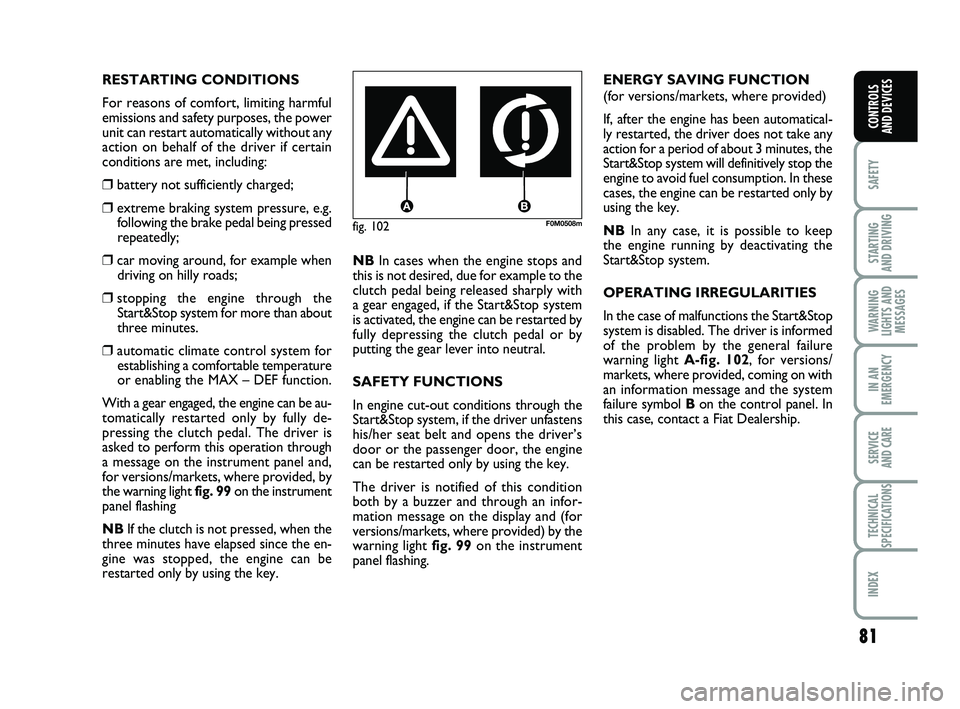
81
SAFETY
STARTING
AND DRIVING
WARNING
LIGHTS AND MESSAGES
IN AN
EMERGENCY
SERVICE
AND CARE
TECHNICAL
SPECIFICATIONS
INDEX
CONTROLS
AND DEVICES
fig. 102F0M0508m
RESTARTING CONDITIONS
For reasons of comfort, limiting harmful
emissions and safety purposes, the power
unit can restart automatically without any
action on behalf of the driver if certain
conditions are met, including:
❒battery not sufficiently charged;
❒extreme braking system pressure, e.g. following the brake pedal being pressed
repeatedly;
❒car moving around, for example whendriving on hilly roads;
❒stopping the engine through theStart&Stop system for more than about
three minutes.
❒automatic climate control system forestablishing a comfortable temperature
or enabling the MAX – DEF function.
With a gear engaged, the engine can be au-
tomatically restarted only by fully de-
pressing the clutch pedal. The driver is
asked to perform this operation through
a message on the instrument panel and,
for versions/markets, where provided, by
the warning light fig. 99 on the instrument
panel flashing
NB If the clutch is not pressed, when the
three minutes have elapsed since the en-
gine was stopped, the engine can be
restarted only by using the key. NB
In cases when the engine stops and
this is not desired, due for example to the
clutch pedal being released sharply with
a gear engaged, if the Start&Stop system
is activated, the engine can be restarted by
fully depressing the clutch pedal or by
putting the gear lever into neutral.
SAFETY FUNCTIONS
In engine cut-out conditions through the
Start&Stop system, if the driver unfastens
his/her seat belt and opens the driver’s
door or the passenger door, the engine
can be restarted only by using the key.
The driver is notified of this condition
both by a buzzer and through an infor-
mation message on the display and (for
versions/markets, where provided) by the
warning light fig. 99 on the instrument
panel flashing. ENERGY SAVING FUNCTION
(for versions/markets, where provided)
If, after the engine has been automatical-
ly restarted, the driver does not take any
action for a period of about 3 minutes, the
Start&Stop system will definitively stop the
engine to avoid fuel consumption. In these
cases, the engine can be restarted only by
using the key.
NB
In any case, it is possible to keep
the engine running by deactivating the
Start&Stop system.
OPERATING IRREGULARITIES
In the case of malfunctions the Start&Stop
system is disabled. The driver is informed
of the problem by the general failure
warning light A-fig. 102, for versions/
markets, where provided, coming on with
an information message and the system
failure symbol B on the control panel. In
this case, contact a Fiat Dealership.
070-090 PUNTO POP 1ed EN 24/03/14 11:36 Pagina 81
Page 93 of 219
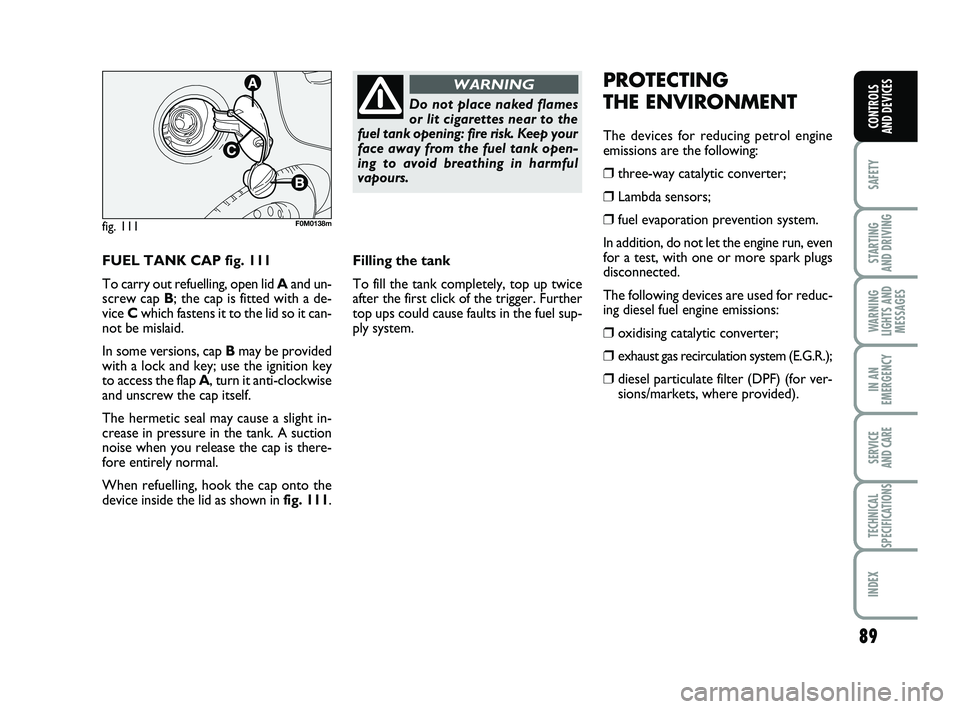
89
SAFETY
STARTING
AND DRIVING
WARNING
LIGHTS AND MESSAGES
IN AN
EMERGENCY
SERVICE
AND CARE
TECHNICAL
SPECIFICATIONS
INDEX
CONTROLS
AND DEVICES
FUEL TANK CAP fig. 111
To carry out refuelling, open lid A and un-
screw cap B ; the cap is fitted with a de-
vice Cwhich fastens it to the lid so it can-
not be mislaid.
In some versions, cap B may be provided
with a lock and key; use the ignition key
to access the flap A, turn it anti-clockwise
and unscrew the cap itself.
The hermetic seal may cause a slight in-
crease in pressure in the tank. A suction
noise when you release the cap is there-
fore entirely normal.
When refuelling, hook the cap onto the
device inside the lid as shown in fig. 111.
fig. 111F0M0138m
Do not place naked flames
or lit cigarettes near to the
fuel tank opening: fire risk. Keep your
face away from the fuel tank open-
ing to avoid breathing in harmful
vapours.
WARNING
Filling the tank
To fill the tank completely, top up twice
after the first click of the trigger. Further
top ups could cause faults in the fuel sup-
ply system.
PROTECTING
THE ENVIRONMENT
The devices for reducing petrol engine
emissions are the following:
❒three-way catalytic converter;
❒Lambda sensors;
❒fuel evaporation prevention system.
In addition, do not let the engine run, even
for a test, with one or more spark plugs
disconnected.
The following devices are used for reduc-
ing diesel fuel engine emissions:
❒oxidising catalytic converter;
❒exhaust gas recirculation system (E.G.R.);
❒diesel particulate filter (DPF) (for ver- sions/markets, where provided).
070-090 PUNTO POP 1ed EN 24/03/14 11:36 Pagina 89
Page 119 of 219
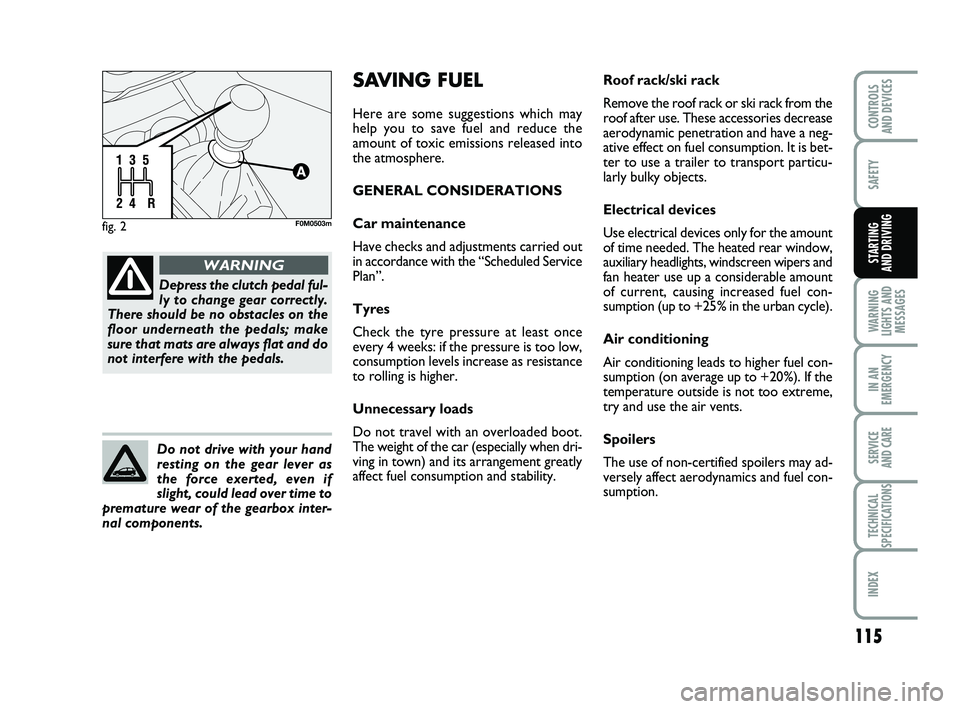
115
SAFETY
WARNING
LIGHTS AND MESSAGES
IN AN
EMERGENCY
SERVICE
AND CARE
TECHNICAL
SPECIFICATIONS
INDEX
CONTROLS
AND DEVICES
STARTING
AND DRIVING
fig. 2F0M0503m
Depress the clutch pedal ful-
ly to change gear correctly.
There should be no obstacles on the
floor underneath the pedals; make
sure that mats are always flat and do
not interfere with the pedals.
WARNING
Do not drive with your hand
resting on the gear lever as
the force exerted, even if
slight, could lead over time to
premature wear of the gearbox inter-
nal components.
Roof rack/ski rack
Remove the roof rack or ski rack from the
roof after use. These accessories decrease
aerodynamic penetration and have a neg-
ative effect on fuel consumption. It is bet-
ter to use a trailer to transport particu-
larly bulky objects.
Electrical devices
Use electrical devices only for the amount
of time needed. The heated rear window,
auxiliary headlights, windscreen wipers and
fan heater use up a considerable amount
of current, causing increased fuel con-
sumption (up to +25% in the urban cycle).
Air conditioning
Air conditioning leads to higher fuel con-
sumption (on average up to +20%). If the
temperature outside is not too extreme,
try and use the air vents.
Spoilers
The use of non-certified spoilers may ad-
versely affect aerodynamics and fuel con-
sumption.SAVING FUEL
Here are some suggestions which may
help you to save fuel and reduce the
amount of toxic emissions released into
the atmosphere.
GENERAL CONSIDERATIONS
Car maintenance
Have checks and adjustments carried out
in accordance with the “Scheduled Service
Plan”.
Tyres
Check the tyre pressure at least once
every 4 weeks: if the pressure is too low,
consumption levels increase as resistance
to rolling is higher.
Unnecessary loads
Do not travel with an overloaded boot.
The weight of the car (especially when dri-
ving in town) and its arrangement greatly
affect fuel consumption and stability.
111-120 PUNTO POP 1ed EN 24/09/13 14.29 Pagina 115
Page 125 of 219
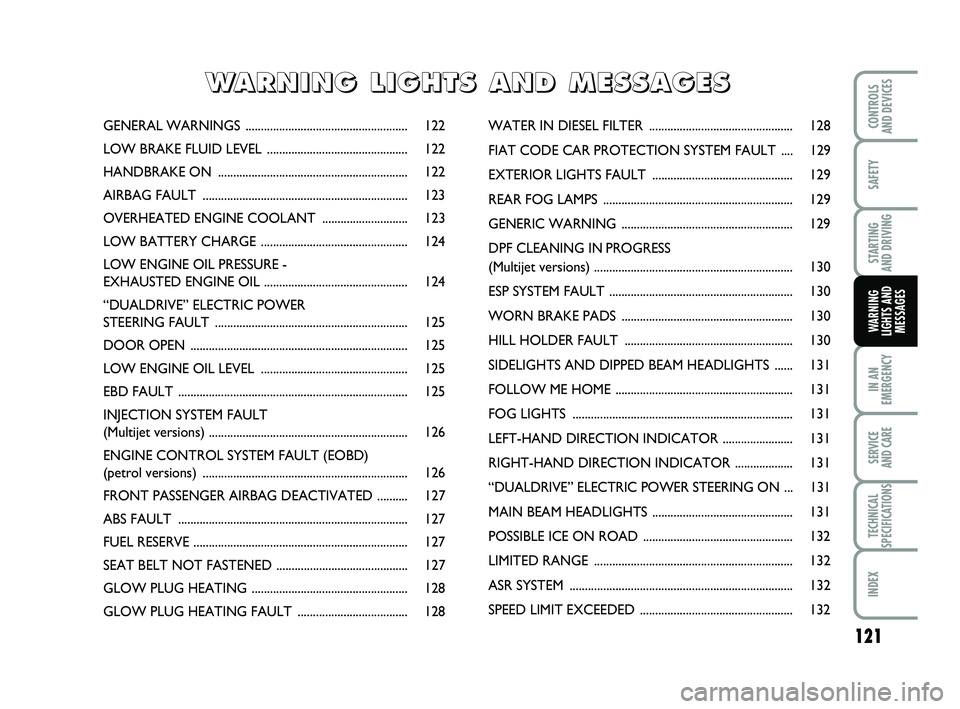
121
SAFETY
STARTING
AND DRIVING
IN AN
EMERGENCY
SERVICE
AND CARE
TECHNICAL
SPECIFICATIONS
INDEX
CONTROLS
AND DEVICES
WARNING
LIGHTS AND MESSAGES
GENERAL WARNINGS ..................................................... 122
LOW BRAKE FLUID LEVEL .............................................. 122
HANDBRAKE ON .............................................................. 122
AIRBAG FAULT ................................................................... 123
OVERHEATED ENGINE COOLANT ............................ 123
LOW BATTERY CHARGE ................................................ 124
LOW ENGINE OIL PRESSURE -
EXHAUSTED ENGINE OIL ............................................... 124
“DUALDRIVE” ELECTRIC POWER
STEERING FAU LT ............................................................... 125
DOOR OPEN .......................................................................\
125
LOW ENGINE OIL LEVEL ................................................ 125
EBD FAULT .......................................................................\
.... 125
INJECTION SYSTEM FAULT
(Multijet vers ions) ................................................................. 126
ENGINE CONTROL SYSTEM FAULT (EOBD)
(petrol vers ions) ................................................................... 126
FRONT PASSENGER AIR BAG DEACTIVATED .......... 127
ABS FAULT .......................................................................\
.... 127
FUEL RESERVE ...................................................................... 127
SEAT BELT NOT FASTENED ........................................... 127
GLOW PLUG H EATING ................................................... 128
GLOW PLUG HEATIN G FAULT .................................... 128 WATER IN DIES
EL FILTER ............................................... 128
FIAT CODE CAR PROTECTION SYSTEM FAULT .... 129
EXTERIOR LIG HTS FAULT .............................................. 129
REAR FOG LAMPS .............................................................. 129
GENERIC WAR NING ........................................................ 129
DPF CLEANING IN PROGRESS
(Multijet versions) ................................................................. 130
ESP SYSTEM FAU LT ............................................................ 130
WORN BRAKE PADS ........................................................ 130
HILL HOLDER FAULT ....................................................... 130
SIDELIGHTS AND DIPP ED BEAM HEADLIGHTS ...... 131
FOLLOW ME HO ME .......................................................... 131
FOG LIGHTS ........................................................................\
131
LEFT-HAND DIRECTION INDICAT OR ....................... 131
RIGHT-HAND DIRECT ION INDICATOR ................... 131
“DUALDRIVE” ELECTRIC POWER STEERING ON ... 131
MAIN BEAM HEADLIGHTS .............................................. 131
POSSIBLE ICE ON ROAD .................................................
132
LIMITED RANGE ................................................................. 132
ASR SYSTEM ......................................................................\
... 132
SPEED LIMIT EXCEEDED .................................................. 132
W
W
A
A
R
R
N
N
I
I
N
N
G
G
L
L
I
I
G
G
H
H
T
T
S
S
A
A
N
N
D
D
M
M
E
E
S
S
S
S
A
A
G
G
E
E
S
S
121-132 PUNTO POP 1ed EN 29/08/13 15.03 Pagina 121
Page 133 of 219
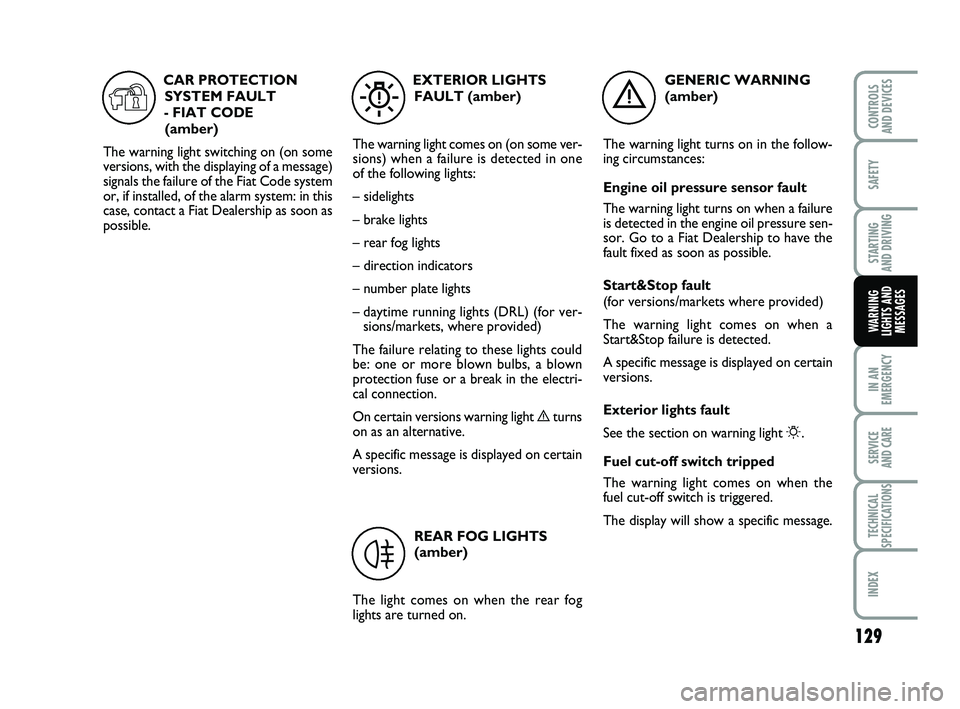
129
SAFETY
STARTING
AND DRIVING
IN AN
EMERGENCY
SERVICE
AND CARE
TECHNICAL
SPECIFICATIONS
INDEX
CONTROLS
AND DEVICES
WARNING
LIGHTS AND MESSAGES
GENERIC WARNING
(amber)
The warning light turns on in the follow-
ing circumstances:
Engine oil pressure sensor fault
The warning light turns on when a failure
is detected in the engine oil pressure sen-
sor. Go to a Fiat Dealership to have the
fault fixed as soon as possible.
Start&Stop fault
(for versions/markets where provided)
The warning light comes on when a
Start&Stop failure is detected.
A specific message is displayed on certain
versions.
Exterior lights fault
See the section on warning light
6.
Fuel cut-off switch tripped
The warning light comes on when the
fuel cut-off switch is triggered.
The display will show a specific message.
è
EXTERIOR LIGHTS FAULT (amber)
The warning light comes on (on some ver-
sions) when a failure is detected in one
of the following lights:
– sidelights
– brake lights
– rear fog lights
– direction indicators
– number plate lights
– daytime running lights (DRL) (for ver- sions/markets, where provided)
The failure relating to these lights could
be: one or more blown bulbs, a blown
protection fuse or a break in the electri-
cal connection.
On certain versions warning light è turns
on as an alternative.
A specific message is displayed on certain
versions.
W
REAR FOG LIGHTS
(amber)
The light comes on when the rear fog
lights are turned on.
4
CAR PROTECTION SYSTEM FAULT
- FIAT CODE (amber)
The warning light switching on (on some
versions, with the displaying of a message)
signals the failure of the Fiat Code system
or, if installed, of the alarm system: in this
case, contact a Fiat Dealership as soon as
possible.
Y
121-132 PUNTO POP 1ed EN 29/08/13 15.03 Pagina 129
Page 171 of 219
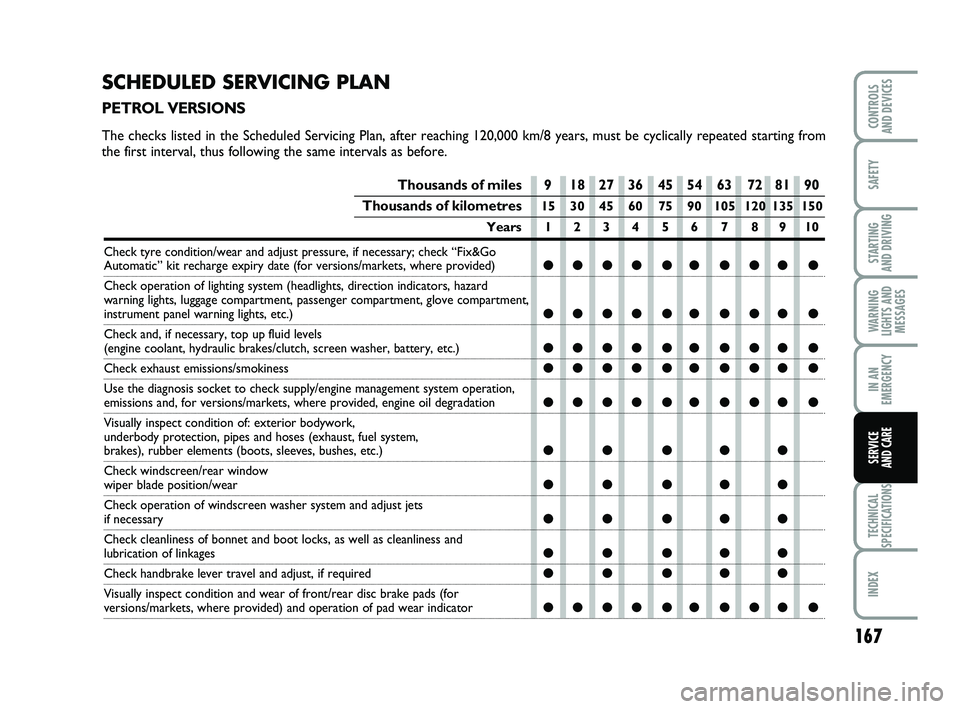
167
SAFETY
STARTING
AND DRIVING
WARNING
LIGHTS AND MESSAGES
IN AN
EMERGENCY
TECHNICAL
SPECIFICATIONS
INDEX
CONTROLS
AND DEVICES
SERVICE
AND CARE
Thousands of miles 9 18 27 36 45 54 63 72 81 90
Thousands of kilometres15 30 45 60 75 90 105 120 135 150
Years 1234 56 7 8910
Check tyre condition/wear and adjust pressure, if necessary; check “F\
ix&Go Automatic” kit recharge expiry date (for versions/markets, where pro\
vided)●●●● ●● ●●● ●
Check operation of lighting system (headlights, direction indicators, h\
azard
warning lights, luggage compartment, passenger compartment, glove compar\
tment,
instrument panel warning lights, etc.)●●●● ●● ●●● ●
Check and, if necessary, top up fluid levels (engine coolant, hydraulic brakes/clutch, screen washer, battery, etc.)\
●●●● ●● ●●● ●
Check exhaust emissions/smokiness●●●● ●● ●●● ●
Use the diagnosis socket to check supply/engine management system operat\
ion, emissions and, for versions/markets, where provided, engine oil degradat\
ion●●●● ●● ●●● ●
Visually inspect condition of: exterior bodywork,
underbody protection, pipes and hoses (exhaust, fuel system,
brakes), rubber elements (boots, sleeves, bushes, etc.)●● ●●●
Check windscreen/rear window wiper blade position/wear●● ●●●
Check operation of windscreen washer system and adjust jets if necessary●● ●●●
Check cleanliness of bonnet and boot locks, as well as cleanliness and lubrication of linkages●● ●●●
Check handbrake lever travel and adjust, if required●● ●●●
Visually inspect condition and wear of front/rear disc brake pads (for \
versions/markets, where provided) and operation of pad wear indicator●●●● ●● ●●● ●
SCHEDULED SERVICING PLAN
PETROL VERSIONS
The checks listed in the Scheduled Servicing Plan, after reaching 120,00\
0 km/8 years, must be cyclically repeated starting from
the first interval, thus following the same intervals as before.
165-184 PUNTO POP 1ed EN 07/04/14 09:35 Pagina 167
Page 173 of 219
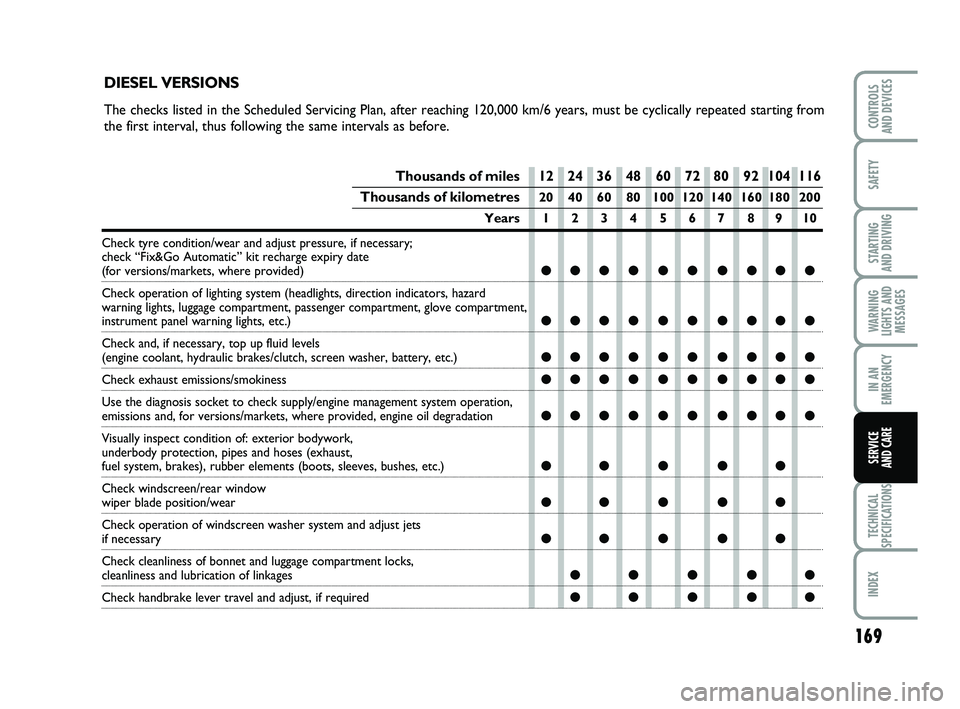
169
SAFETY
STARTING
AND DRIVING
WARNING
LIGHTS AND MESSAGES
IN AN
EMERGENCY
TECHNICAL
SPECIFICATIONS
INDEX
CONTROLS
AND DEVICES
SERVICE
AND CARE
Thousands of miles 12 24 36 48 60 72 80 92 104 116
Thousands of kilometres20 40 60 80 100 120 140 160 180 200
Years 1234 567 8910
Check tyre condition/wear and adjust pressure, if necessary;
check “Fix&Go Automatic” kit recharge expiry date
(for versions/markets, where provided)●●●● ●● ●●●●
Check operation of lighting system (headlights, direction indicators, h\
azard
warning lights, luggage compartment, passenger compartment, glove compar\
tment,
instrument panel warning lights, etc.)●●●● ●● ●●●●
Check and, if necessary, top up fluid levels (engine coolant, hydraulic brakes/clutch, screen washer, battery, etc.)\
●●●● ●● ●●●●
Check exhaust emissions/smokiness●●●● ●● ●●●●
Use the diagnosis socket to check supply/engine management system operat\
ion, emissions and, for versions/markets, where provided, engine oil degradat\
ion●●●● ●● ●●●●
Visually inspect condition of: exterior bodywork,
underbody protection, pipes and hoses (exhaust,
fuel system, brakes), rubber elements (boots, sleeves, bushes, etc.)●●●●●
Check windscreen/rear window wiper blade position/wear●●●●●
Check operation of windscreen washer system and adjust jets if necessary●●●●●
Check cleanliness of bonnet and luggage compartment locks, cleanliness and lubrication of linkages●● ● ●●
Check handbrake lever travel and adjust, if required●● ● ●●
DIESEL VERSIONS
The checks listed in the Scheduled Servicing Plan, after reaching 120,00\
0 km/6 years, must be cyclically repeated starting from
the first interval, thus following the same intervals as before.
165-184 PUNTO POP 1ed EN 07/04/14 09:35 Pagina 169
Page 175 of 219
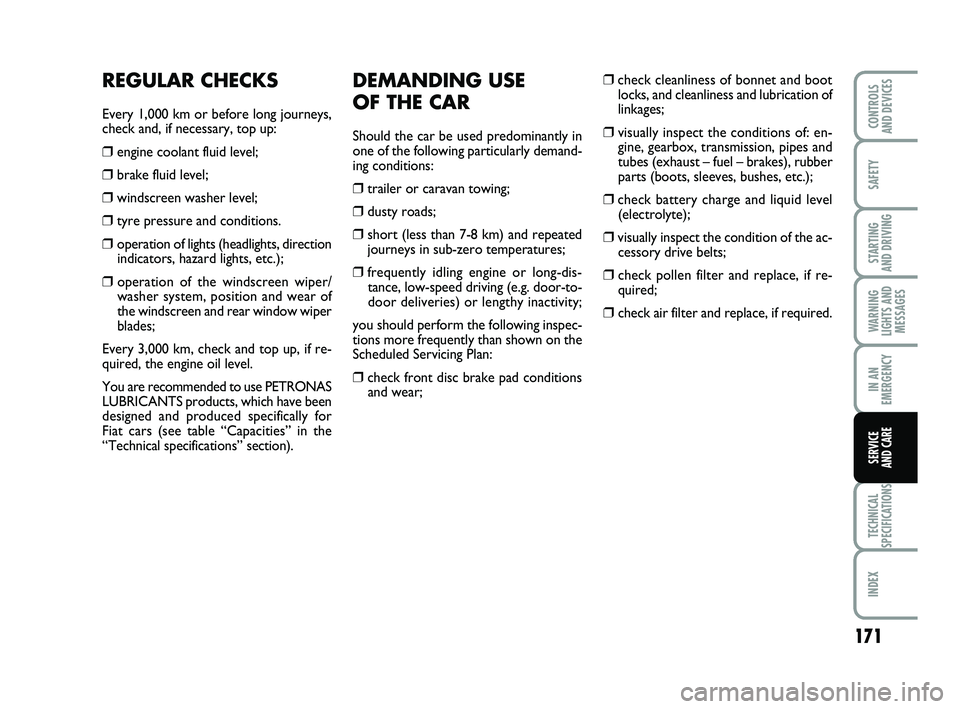
171
SAFETY
STARTING
AND DRIVING
WARNING
LIGHTS AND MESSAGES
IN AN
EMERGENCY
TECHNICAL
SPECIFICATIONS
INDEX
CONTROLS
AND DEVICES
SERVICE
AND CARE
DEMANDING USE
OF THE CAR
Should the car be used predominantly in
one of the following particularly demand-
ing conditions:
❒trailer or caravan towing;
❒dusty roads;
❒short (less than 7-8 km) and repeated journeys in sub-zero temperatures;
❒ frequently idling engine or long-dis- tance, low-speed driving (e.g. door-to-
door deliveries) or lengthy inactivity;
you should perform the following inspec-
tions more frequently than shown on the
Scheduled Servicing Plan:
❒ check front disc brake pad conditions and wear;
❒check cleanliness of bonnet and bootlocks, and cleanliness and lubrication of
linkages;
❒ visually inspect the conditions of: en- gine, gearbox, transmission, pipes and
tubes (exhaust – fuel – brakes), rubber
parts (boots, sleeves, bushes, etc.);
❒check battery charge and liquid level(electrolyte);
❒visually inspect the condition of the ac-cessory drive belts;
❒check pollen filter and replace, if re-
quired;
❒check air filter and replace, if required.
REGULAR CHECKS
Every 1,000 km or before long journeys,
check and, if necessary, top up:
❒engine coolant fluid level;
❒brake fluid level;
❒windscreen washer level;
❒tyre pressure and conditions.
❒operation of lights (headlights, directionindicators, hazard lights, etc.);
❒operation of the windscreen wiper/
washer system, position and wear of
the windscreen and rear window wiper
blades;
Every 3,000 km, check and top up, if re-
quired, the engine oil level.
You are recommended to use PETRONAS
LUBRICANTS products, which have been
designed and produced specifically for
Fiat cars (see table “Capacities” in the
“Technical specifications” section).
165-184 PUNTO POP 1ed EN 07/04/14 09:35 Pagina 171
Page 184 of 219
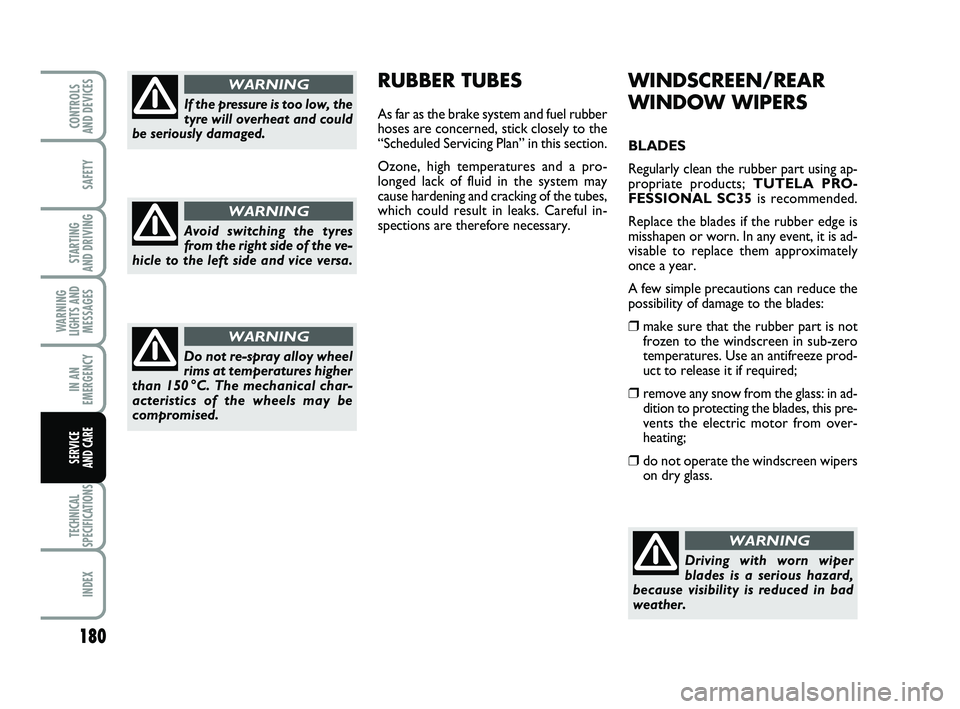
180
SAFETY
STARTING
AND DRIVING
WARNING
LIGHTS AND MESSAGES
IN AN
EMERGENCY
TECHNICAL
SPECIFICATIONS
INDEX
CONTROLS
AND DEVICES
SERVICE
AND CARE
WINDSCREEN/REAR
WINDOW WIPERS
BLADES
Regularly clean the rubber part using ap-
propriate products; TUTELA PRO-
FESSIONAL SC35 is recommended.
Replace the blades if the rubber edge is
misshapen or worn. In any event, it is ad-
visable to replace them approximately
once a year.
A few simple precautions can reduce the
possibility of damage to the blades:
❒make sure that the rubber part is not
frozen to the windscreen in sub-zero
temperatures. Use an antifreeze prod-
uct to release it if required;
❒remove any snow from the glass: in ad-
dition to protecting the blades, this pre-
vents the electric motor from over-
heating;
❒do not operate the windscreen wipers
on dry glass.
Driving with worn wiper
blades is a serious hazard,
because visibility is reduced in bad
weather.
WARNING
RUBBER TUBES
As far as the brake system and fuel rubber
hoses are concerned, stick closely to the
“Scheduled Servicing Plan” in this section.
Ozone, high temperatures and a pro-
longed lack of fluid in the system may
cause hardening and cracking of the tubes,
which could result in leaks. Careful in-
spections are therefore necessary.If the pressure is too low, the
tyre will overheat and could
be seriously damaged.
WARNING
Avoid switching the tyres
from the right side of the ve-
hicle to the left side and vice versa.
WARNING
Do not re-spray alloy wheel
rims at temperatures higher
than 150 °C. The mechanical char-
acteristics of the wheels may be
compromised.
WARNING
165-184 PUNTO POP 1ed EN 07/04/14 09:35 Pagina 180